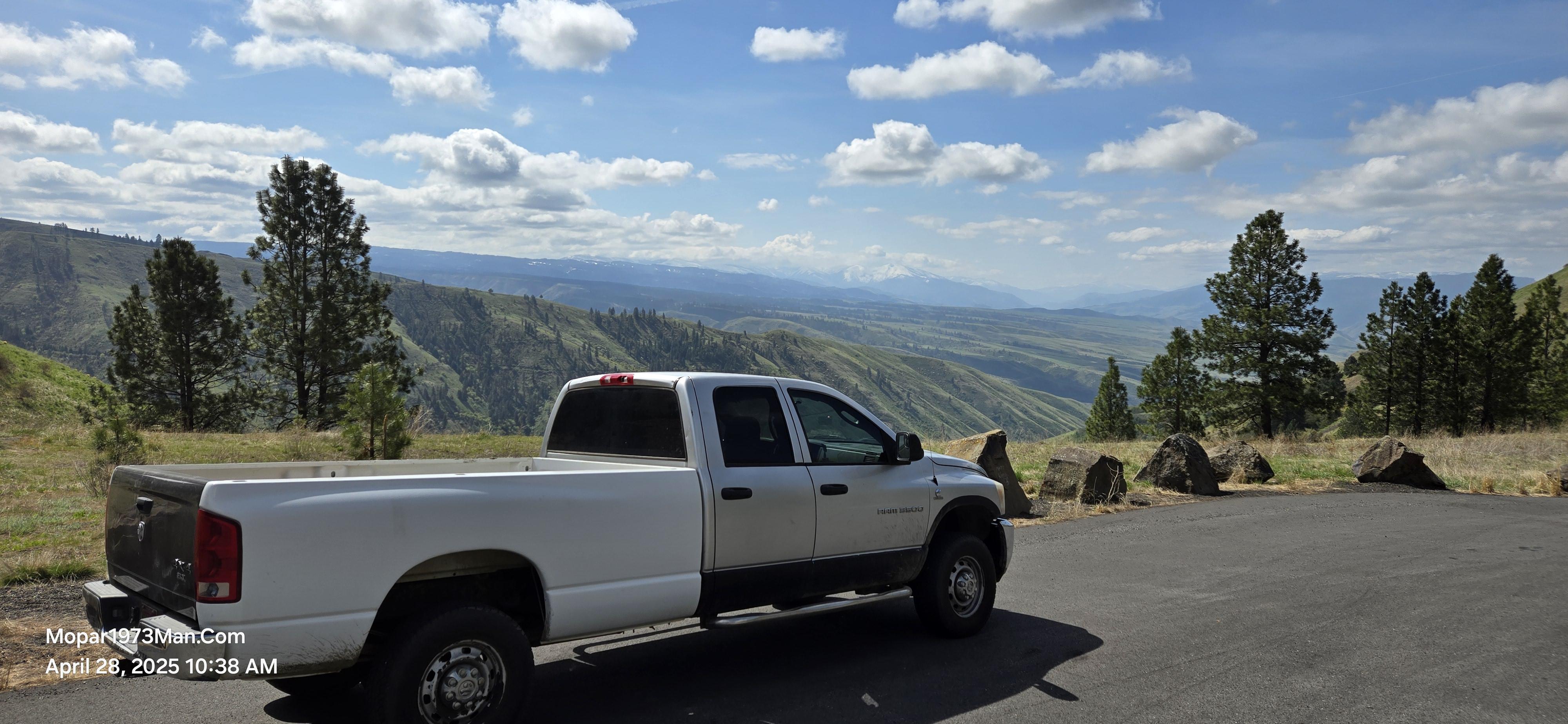
Everything posted by Mopar1973Man
-
Idaho is now over $4.00 buck a gallon for Diesel!
Riggins, ID (Yes... I just pumped a $100 dollar bill in my tank... 8| ) New Meadows, ID
-
What's on your BOMB list????
Nice and simple bomb list but could be rather threatening to others... >
-
Tires
Like me... I went with the Cooper's and enjoyed them this winter. I've never chained up or been stuck in the snow. Which is great but now that the snow is gone I really don't need such a aggressive tire for just highway applications. So I've still got my stock tire from the dealer and I'm going to switch over to them for the summer months. That will save my Cooper's ($1,300 worth) for next winter... Highway tires as fairly inexpensive really compared to a aggressive over road tire... :wow
-
stuck rings
Hmmm... Let me see what the "Big O' Book" says... :wow It says to much to cut and paste to this forum... LOL But still and all I don't think your going to be hurt to bad for a few thou's of extra space. But I bet that cylinder will be the first one to give you trouble in the long haul. (Oil burn).
-
stuck rings
I heard of guys sleeving a cylinder to repair damage... I've seen only one ford gasser ever done...
-
banks exposed
Ask yourself how many forums do you see advertising BANK's products? :rolleyes LOL
-
Where did that deer go???
Deer hamburger anyone??? LOL
-
a video I shot tonight
I'm not impressed with Banks at all... In all the forums on the internet there is so little of him around... (Products etc.) :rolleyes
-
UPDATE! Aug 28, 2007 - MPG and Cost per mile
Yeah... I was using pics from the static web site but the pics are now long gone... But I could send you the links to the PDF files that now replace them... :thumbsup http://mopar.mopar1973man.com/cummins/general/better-mpgs/better-mpgs.htm 128:1 ratio is what I normally run... As for what you added or how much to 100 gallons of fuel... :confused: You got me... :rolleyes
-
Fuel Additives Again
Here you go... http://mopar.mopar1973man.com/cummins/general/2-cycle-oil/2-cycle-oil.htm http://mopar.mopar1973man.com/cummins/general/2-cycle-oil/failure/failure.htm
-
Sec Gen/ Air Intake / battery relocate
snag his butt and drag him over... :wow LOL
-
Re-mounting a Frantz filter
I'm still scared to punch any holes in my pan to this day... :wow
-
Fuel Additives Again
Like me I buy 4 gallons of Supertech Outboard oil in the spring and fall... $8.00 x 4 = $32 for 6 months of fuel treatment $32 x 2 = $64 for the entire year for 2 cycle oil... Still cheaper for Wally World oil... LOL
-
Re-mounting a Frantz filter
Well on the Frantz Filter setup there is a restriction fitting in the input side of the filter to reduce the flow so it doesn't blow out the can seals. As for return if you can tap the return line of the turbos you would be fine... I'm not very happen with the return in the cap either. If I could change that I would but I'm not going to drill holes in my valve cover. But I know there is a nice plug in the crankcase near the pan I could use...
-
Fuel Additives Again
MattyMx is right...PS is much lower on the lubricity measurement compared to Standyne... But If you use very little of the PS say (2-5 Ozs) per full tank of guel you'll be able to rid yourself of it without reducing the HFRR to much. But if you wanted to get rid of quickly get some Opti-lube and use the two products together. That way the Opti-lube builds up a good lubricity and the PS can piggy back with suck it back down to bad...
-
EMISSION TESTING REQUIREMENT
No not yet for New Meadows, Id... But for larger cities like Boise, ID and such do have emission control testing. :rolleyes Coming to city near you! :confused:
-
Wireing in a heated power seat.
Well I got something right up your alley... There is all the wiring on heated seat for 2001 trucks which should work for you... :thumbsup
-
HFRR question
That was just point improvement... LOL 636 HFRR - 162 Point Improvement = 474 HFRR (200:1 Ratio - Known Information)636 HFRR - 324 Point Improvement = 312 HFRR (100:1 Ratio - Thoery...)
-
EMISSION TESTING REQUIREMENT
That's when I take my Edge comp and shove it back into the dash temporarily and set it on 1x1 and run the test... LOL
-
HFRR question
I admit your right... About the math... I tend to like to keep things simple...But as for taking up a collection it would be rather difficult being my member base is rather small and random. :rolleyesNow if the member base was to improve and there was a show of activity I would say we had a chance at getting this testing done on the fuel and 2 cycle oil. So Keydl are you willing to bring more members in to the group??? :confused:
-
Standing my ground concerning 2 cycle oil...
That's what's so amazing... That a company like PowerService is advertising a product that contain a secret chemical called "SlickDiesel" but in there own FAQs section on there site they point out that PS only meets the 520 HFRR standard. Nothing else said about exceeding the standard just meeting it. Well geez... That's like saying we are just as good as the ULSD but we got Slick diesel... :rolleyes Then there is MMO. A product that has the word "OIL" on the bottle and everyone flocked to it thinking it would lubricant anything and everything. But it so far from the truth again. It doesn't even contain a lubricant in it... :rolleyes The list goes on... Like I made a comment on a site once before that if I took 2 cycle oil and relabeled it as "Mopar1973Man's Diesel Fuel Lubricant" and sold it to the public there won't be a second though about it. Because I'm a company producing a product and that's considered SAFE! :nono :rolleyes This is the point I'm making no one is willing to research anything at all to protect what they got... But these same people are the very same ones that shoot me down at their first chance... :mad
-
HFRR question
Well just for simple math...200:1 Ratio is 162 Point improvement...100:1 Ratio is ~324 Point Improvement (162 x 2 =324)
-
Standing my ground concerning 2 cycle oil...
Thank you for you great comments guys...
-
Hill-Billy...
That's scary... :wow
-
Removing Running Boards
Hey Now... No plumber butt... Just a hard work guy fighting rusted bots and nuts... We even scored them with a hacksaw and broke them off with a hammer... :wow


